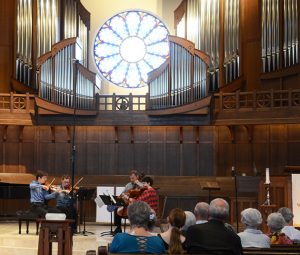
Finding your own way of engaging with the performers is the best way to enjoy a concert, as done here with Camerata San Antonio. Photo by Phil Houseal
Sept 27, 2017–How do you listen to a music performance?
Is there a right or a wrong way?
I thought about this while I attended the spring concert of Camerata San Antonio, a classical music ensemble. I was there to take photos, but as I settled into the back pew I succumbed to the music. Surveying the intimate audience, I noticed some were moving to the rhythm, some were listening with their eyes shut, and one was hunched over a smartphone.
But is external posture proof of internal engagement?
In one of my early columns I noted (with misplaced derision) our tendency to doze off during an afternoon concert. Now I wonder if that is not in fact the proper method–to close your eyes, lean back, relax, and forget about the clogged drain, the thistles in the ditch, and whether you need to stop at the store on the way home.
As a starting point for my experiment on “how to listen,” I went back to an earlier lesson I had on “how to play.”
It’s a question I asked my conductor when, as a nervous adult beginner violin player, I tuned up for a first performance.
“Forget yourself,” was her unexpected answer. “Instead, focus on presenting this wonderful music to your audience. Play for them, and think about what the composer is doing with the music.”
I perceived this as being like your first teenage breakup–it’s not about you. The musician, no matter how gifted, is merely the conduit through which the composer speaks across centuries. That perspective worked. I immediately forgot about my inadequacies and focused on the brilliance of the music.
I was curious if this approach worked on the other side. I wanted to be an active listener. I like to write, so I decided to take notes during the concert. Is that allowed? Why not? So I took out a yellow legal pad and began.
The result? It made it a much more enjoyable–and engaging–experience. I wrote ideas about how the music made me feel. What was the composer trying to convey? What does the interplay of the viola with the cello represent? How is the theme repeated and rearranged through each movement? What image does this line create?
(Observation: You need no musical background to do this. In my only college music theory class the assignment was to write a review of a classical piece. I selected Prokofiev’s March for the Love of Three Oranges because I thought the name sounded funny. It was a futile task for a farm boy whose musical references were Hank Williams and The Monkees. I had absolutely no vocabulary for discussing classical music. It was less than stellar writing, but to this day, I feel a special connection with that piece.)
Finally, I set down the notes and leaned back, closed my eyes, and just listened. I even may have dozed. But the effect lived.
It reminds you there is something greater beyond the daily grind. When it is good, it touches “forever,” whatever that happens to mean for you.
Footnote:
At intermission I went over to the audience member who had been studying his smart phone. I was surprised to discover he was looking at a musical score. Turns out he was a string player and was scrolling ahead in the piece being performed in order to help him anticipate and appreciate the music that much more.
So I learned there is no “right” way to experience music. Or art, or wine, or any other esoteric pursuit. The fact you choose to experience it at all is what matters.
Details:
Camerata San Antonio will perform its Season Opener concert in Kerrville, TX, on Saturday, September 30, beginning at 3PM in First Presbyterian Church, 800 E. Jefferson Street. Admission is by donation. Complete concert schedule, programs, and ticket information is online at www.cameratasa.org.